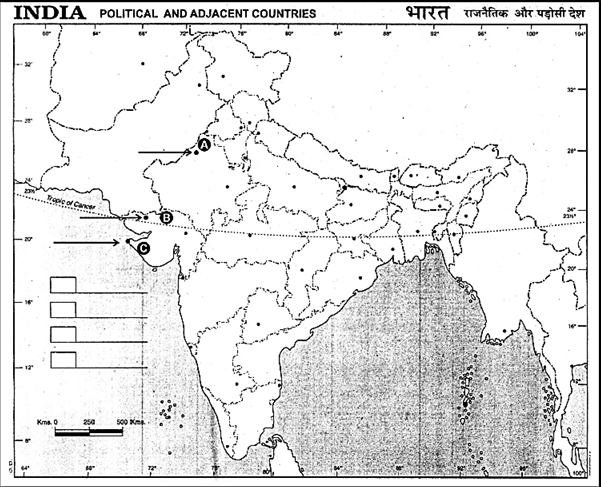 Short Answer Type
Short Answer TypeThe burials in Harappan sites reveal the economic and social differences amongst the people living within a particular culture. Give two evidences in support of your answer.
What evidences have been put forward to explain the collapse of the Harappan Civilization ?
On the given outline political map of India locate and label the following with appropriate symbols:
(a) Ajmer, a territory under Mughals.
(b) Gwalior, a centre of the Revolt of 1857.
On the same map three places related to the mature Harappan sites has been marked as A, B, C. Identify them and write their names correctly on the lines drawn near them.
Why were many Zamindaris auctioned after the Permanent Settlement in Bengal ? Give two reasons.
‘Kabir was and is to the present a source of inspiration for those who questioned entrenched social institutions and ideas in their search for divine.’ Explain.
(i) He believed in the Nirguna Bhakti.
(ii) The range of traditions Kabir drew on to describe the Ultimate
Reality include Islam: as Allah, Khuda, Hazrat and Pir.
(iii) Verses ascribed to kabir have been compiled in the Kabir Bijak,
Kabir Granthavali and Adi Grantha Sahib.
(iv) He also used terms drawn from Vedantic traditions, alakh (the unseen), nirakar formless), Brahman, Atman, etc. (v) The terms with mystical connotations such as shabda (sound) or shunya (emptiness) were drawn from yogic traditions.
(vi) He questioned entrenched religious and social institutions, ideas and practices in their search for the Divine.
(vii) He probably crystallised through dialogue and debate with the traditions of Sufis and Yogis.
(viii) He believed in divinity rather than any particular religion.
(ANY FOUR)
“The nobility was recruited consciously by the Mughal rulers from diverse ethnic and religious groups.” Justify.
Examine the circumstances that led to the passing of ‘Limitation Laws’ by the British in 1859.
